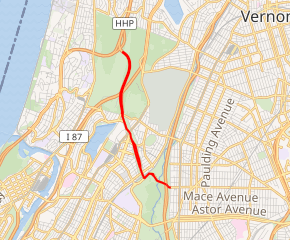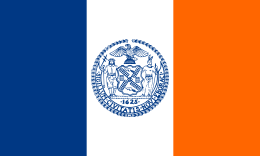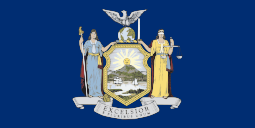Mosholu Parkway
Mosholu Parkway is a hybrid freeway-standard parkway and grade-level roadway in the New York City borough of the Bronx, constructed from 1935 to 1937 as part of the roadway network created under Robert Moses. The roadway extends for 3.0 miles (4.8 km) between the New York Botanical Garden (where its southeast end meets the Bronx River Parkway) and Van Cortlandt Park (where its northwest end meets the Henry Hudson Parkway). The New York City Department of Transportation is responsible for the operation and maintenance of the roadway while the New York City Department of Parks and Recreation is responsible for the surrounding rights-of-way. The parkway is designated as New York State Route 908F (NY 908F), an unsigned reference route, by the New York State Department of Transportation.
| |
|---|---|

Mosholu Parkway highlighted in red | |
| Route information | |
| Maintained by NYCDOT | |
| Length | 3.03 mi[1] (4.88 km) |
| Restrictions | No trucks, trailers, or buses. |
| Major junctions | |
| South end | |
| North end | |
| Location | |
| Counties | Bronx |
| Highway system | |
Route description
Mosholu Parkway begins at exit 8E of the Bronx River Parkway. It heads northward as an arterial boulevard through the northern parts of the Bronx. The highway crosses through Bedford Park, passing Bainbridge Avenue. It intersects with the Grand Concourse afterwards, with Jerome Avenue, Sedgwick Avenue and West Gun Hill Road soon after. Within Van Cortlandt Park, the parkway becomes a limited-access freeway, with exits for the southbound Major Deegan Expressway (Interstate 87) and the Henry Hudson Parkway near its northern terminus at the Westchester County line (where it turns into the Saw Mill River Parkway).[2]
A bikeway, part of the East Coast Greenway, runs along the northeast side of the parkway from Bronx Park to Van Cortlandt Park, connecting through the park to other trails and playing fields and to Broadway.[2]
History
Etymology
There are conflicting accounts as to what "Mosholu" is derived from. According to one account, "Mosholu" is an Algonquin word meaning "smooth stones" or "small stones", and was first applied to the nearby creek now known as Tibbetts Brook. The southern end of the parkway was once home to another creek called Schuil Brook, running under what is now Middlebrook Road, which supplied water to a British fort located on old Van Cortlandt Avenue East during the American Revolutionary War.[3][4]
According to another etymology, Mosholu is a contraction of the name of the Choctaw chief Mushulatubbee. The Choctaw were not local to New York, but Mushulatubbee was well known for his assistance to the US during the War of 1812. A variant form of the contracted name was given to two ships; the USS Mashula (launched as USS Severn in 1867) and the SS Moshulu. The latter ship was apparently named with the understanding that it was a Seneca word meaning fearless.[5]
Context
In the 1870s, landscape architect Frederick Law Olmsted envisioned a greenbelt across the Bronx, consisting of parks and parkways that would align with existing geography.[6][7]:47 However, in 1877, the city declined to act upon his plan.[8] Around the same time, New York Herald editor John Mullaly pushed for the creation of parks in New York City, particularly lauding the Van Cortlandt and Pell families' properties in the western and eastern Bronx respectively. He formed the New York Park Association in November 1881.[7]:49[9] There were objections to the system, which would apparently be too far from Manhattan, in addition to precluding development on the parks' sites.[10][11] However, newspapers and prominent lobbyists, who supported such a park system, were able to petition the bill into the New York State Senate, and later, the New York State Assembly (the legislature's lower house).[10]:56[12]
In June 1884, Governor Grover Cleveland signed the New Parks Act into law, authorizing the creation of the park system.[10][11][13] The system consisted of three parkways and six parks, with Bronx Park at the center of the system. Bronx Park was connected to Van Cortlandt Park in the northwest via Mosholu Parkway; to Pelham Bay Park in the east via Pelham Parkway; and to Crotona Park in the south via Crotona Parkway. There were no direct connections to Claremont Park and St. Mary's Park, the other two parks in the system.[7]:48
Reconstruction
The road was reconstructed between 1935 and 1937, including widening the entire parkway, making the section from the Saw Mill to Gun Hill Road, replacing the intersection at Jerome Avenue with an overpass, and installing a wide median between Marion Avenue and Grand Concourse.[14]
Exit list
The entire route is in the New York City borough of the Bronx. All exits are unnumbered.
| Location | mi[1][15] | km | Destinations | Notes | |
|---|---|---|---|---|---|
| Bronx Park | 0.00 | 0.00 | Bronx Park East / Allerton Avenue | Northern terminus of Southern Boulevard; southern terminus of NY 908F; located near Allerton Avenue station | |
| 0.03– 0.40 | 0.048– 0.64 | Cloverleaf interchange; exit 8 on the Bronx River Parkway | |||
| 0.53 | 0.85 | Southern Boulevard south – Fordham Road, Botanical Garden | NY 908F transitions between Southern Boulevard and Mosholu Parkway; located near Botanical Garden station | ||
| Norwood | 0.75 | 1.21 | Marion Avenue | ||
| 0.85 | 1.37 | Bainbridge Avenue | |||
| 1.20 | 1.93 | Van Cortlandt Avenue | |||
| Bedford Park | 1.38 | 2.22 | Grand Concourse south | Northbound access is via Van Cortlandt Avenue; located near Bedford Park Boulevard station | |
| 1.50 | 2.41 | Paul Avenue to Jerome Avenue – Lehman College | Located near Mosholu Parkway station | ||
| 1.70 | 2.74 | ||||
| 1.80 | 2.90 | Gun Hill Road | |||
| Southern terminus of freeway | |||||
| Goulden Avenue | Southbound exit only | ||||
| Van Cortlandt Park | 2.30 | 3.70 | Southbound exit and northbound entrance; exit 12 on I-87 | ||
| 3.50 | 5.63 | Northern terminus; exit 24 on Henry Hudson Parkway | |||
1.000 mi = 1.609 km; 1.000 km = 0.621 mi
| |||||
See also



- Bedford Park, the neighborhood on the southern side of Mosholu Parkway
- Norwood, the neighborhood on the northern side of Mosholu Parkway
- Bronx Park, the neighborhood and park at the eastern end of Mosholu Parkway
- Van Cortlandt Park, the park at the western end of Mosholu Parkway
References
- "2007 Traffic Data Report for New York State" (PDF). New York State Department of Transportation. July 25, 2008. Archived from the original (PDF) on June 12, 2012. Retrieved May 29, 2009.
- Google (June 6, 2008). "overview map of Mosholu Parkway" (Map). Google Maps. Google. Retrieved June 6, 2008.
- "Mosholu Parkway". New York City Department of Parks and Recreation. March 9, 2001. Retrieved April 2, 2010.
- McNamara, John (1984). History in asphalt : the origin of Bronx street and place names, Borough of the Bronx, New York City. Bronx, N.Y: Bronx County Historical Society. p. 180. ISBN 978-0-941980-16-6. OCLC 10696584.
- Robert S. Grumet, Manhattan to Minisink: American Indian Place Names of Greater New York and Vicinity, University of Oklahoma Press, 2013 ISBN 0806189134. p. 219.
- Olmsted, Frederick Law; Vaux, Calvert; Croes, John James Robertson (1968). Fein, Albert (ed.). Landscape into cityscape: Frederick Law Olmsted's plans for a greater New York City. Cornell University Press. p. 331.
- Gonzalez, Evelyn (June 5, 2004). The Bronx. Columbia University Press. ISBN 978-0-231-50835-3. Retrieved January 8, 2017.
- Golan, Michael (1975). "Bronx Parks: A Wonder From the Past". Bronx County Historical Society Journal. The Bronx County Historical Society. 12 (2): 32–41.
- "The Need of More Parks; First Meeting of the New-York Park Association Yesterday". The New York Times. 1881-11-27. ISSN 0362-4331. Retrieved 2019-08-18.
- "Van Cortlandt Park, Borough of the Bronx: Restoration Master Plan, Part 1" (PDF). New York City Parks Department, Storch Associates. 1986. Retrieved August 18, 2019.
- "The Albany Legislators.; Parks for New-York City—Limiting Mayor Edson's Appointments". The New York Times. 1884-03-25. ISSN 0362-4331. Retrieved 2019-08-18.
- Mullaly, John (1887). The New Parks Beyond the Harlem: With Thirty Illustrations and Map. Descriptions of Scenery. Nearly 4,000 Acres of Free Playground for the People. New York: Nabu Press. pp. 117–138. ISBN 978-1-141-64293-9.
- "Proposed New Parks". The New York Times. 1884-01-24. ISSN 0362-4331. Retrieved 2019-08-18.
- "Draft Final Report Van Cortlandt Park Pedestrian Bridge Feasibility Study" (PDF). pp. 1–2. Retrieved 9 August 2018.
- Google (January 5, 2016). "Mosholu Parkway" (Map). Google Maps. Google. Retrieved January 5, 2016.
External links
| Wikimedia Commons has media related to Mosholu Parkway. |
- Mosholu Parkway at
- Mosholu Parkway page at nycroads.com
